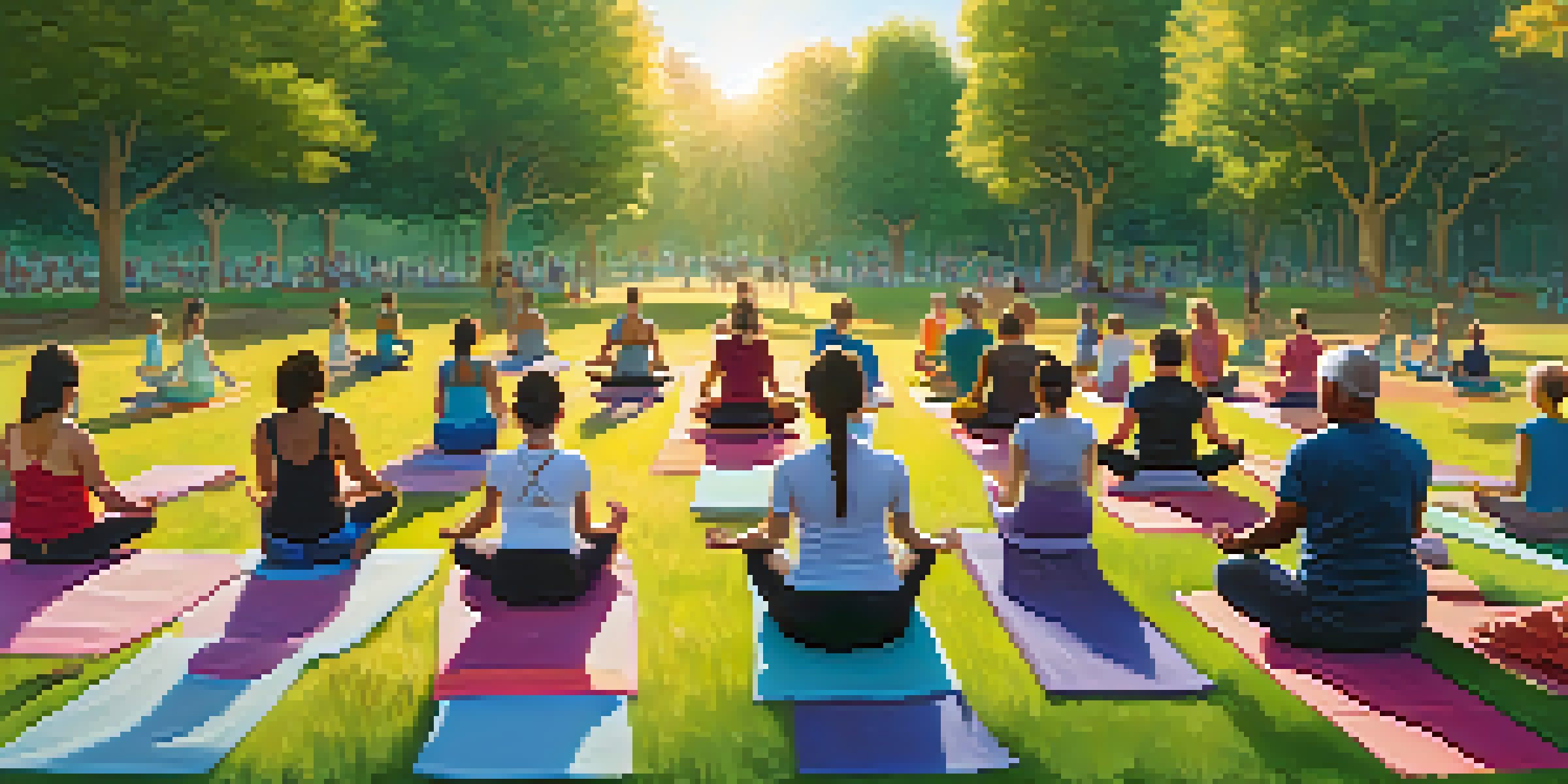Yoga as a Tool for Social Cohesion and Cultural Exchange

Understanding Yoga's Role in Community Building
Yoga isn't just about physical poses; it's a powerful tool for fostering community. As people come together to practice, they create shared experiences that build camaraderie. This sense of belonging can transcend individual differences, uniting participants through a common goal of wellness.
Yoga is the journey of the self, through the self, to the self.
In group classes, the energy of the participants enhances the experience, making everyone feel connected. The shared breath and synchronized movements can create a profound sense of unity. This connectedness often leads to friendships and support networks that extend beyond the yoga mat.
Moreover, community-oriented yoga events, such as workshops or outdoor classes, can draw diverse groups. These gatherings promote not only physical health but also social interaction, which is essential for cultivating long-lasting relationships.
Yoga as a Medium for Cultural Exchange
Yoga's global popularity has turned it into a cultural bridge. Practitioners from various backgrounds can share their unique interpretations and practices, enriching the yoga community. This exchange of ideas and traditions fosters mutual respect and understanding among different cultures.

For instance, a yoga class might incorporate elements of Indian philosophy while embracing Western fitness techniques. This blend allows participants to experience a wider perspective, enhancing their understanding of yoga's roots and its evolution. Such cultural exchanges can lead to deeper conversations about heritage and identity.
Yoga Builds Community Connections
Group yoga practices foster shared experiences that create lasting bonds and support networks among participants.
Additionally, yoga festivals often celebrate these diverse influences, inviting instructors from around the world. Attendees not only learn new practices but also engage in discussions that highlight the beauty of cultural diversity within the yoga community.
Promoting Inclusivity Through Yoga Practices
Inclusivity is a cornerstone of yoga philosophy, which emphasizes acceptance and compassion. By creating inclusive spaces, yoga studios can welcome individuals of all backgrounds, abilities, and ages. This openness encourages participation from those who may feel marginalized in other areas of society.
In the practice of tolerance, one's enemy is the best teacher.
Specialized classes, such as chair yoga or adaptive yoga, cater to individuals with varying physical abilities. These classes ensure that everyone has the opportunity to experience the benefits of yoga, regardless of their starting point. It’s a beautiful reminder that yoga can be for everyone, fostering a sense of belonging.
Furthermore, by promoting diverse instructors and teaching styles, studios can reflect the rich tapestry of the community. This representation not only empowers instructors but also resonates with students, making yoga a truly inclusive practice.
Yoga Retreats: A Space for Shared Experiences
Yoga retreats offer a unique opportunity for participants to immerse themselves in collective learning. By stepping away from daily routines, individuals can connect deeply with one another. This shared experience often leads to lasting friendships and a sense of community that extends beyond the retreat.
During these retreats, participants often share meals, stories, and their yoga journeys, which fosters a sense of kinship. The combination of physical practice and emotional bonding can create a powerful environment for cultural exchange. These connections can break down barriers and encourage open dialogue among diverse groups.
Cultural Exchange Through Yoga
Yoga serves as a cultural bridge, allowing practitioners to share diverse traditions and enhance mutual respect.
Moreover, many retreats are located in culturally rich areas, allowing participants to engage with local customs and traditions. This interaction can enhance understanding and appreciation for different cultures, making the retreat experience even more enriching.
The Intersection of Yoga and Social Activism
Yoga is increasingly being recognized as a form of social activism. Many practitioners use their platforms to advocate for social justice, mental health awareness, and community support. This activism can bring together individuals from various backgrounds who share a common purpose.
By participating in charity yoga classes or community outreach programs, yogis can contribute positively to society while strengthening their bonds with others. These events often highlight pressing social issues, promoting awareness and encouraging proactive solutions.
Furthermore, the mindfulness cultivated through yoga practice can empower individuals to engage thoughtfully with social issues. This awareness can lead to compassionate action, creating ripples of positive change within communities.
Building Resilience and Empathy Through Yoga
Yoga cultivates resilience and empathy, essential traits for fostering social cohesion. As individuals learn to navigate their own challenges through practice, they become more understanding and supportive of others. This shared journey of self-discovery can deepen connections among group members.
The practice encourages individuals to listen to their bodies and emotions, promoting emotional intelligence. As yoga practitioners become more in tune with their feelings, they can better empathize with the experiences of others. This heightened awareness can lead to more meaningful interactions and relationships.
Inclusivity in Yoga Practices
By promoting diverse classes and instructors, yoga studios can create welcoming spaces for individuals of all backgrounds and abilities.
Additionally, group practices often emphasize mutual support, creating a nurturing environment. When individuals feel safe and valued, they are more likely to extend that compassion outward, contributing to a more cohesive community.
Conclusion: Embracing Yoga for a Unified Future
Yoga, with its rich history and diverse practices, has the potential to be a unifying force in our increasingly divided world. By embracing yoga as a tool for social cohesion and cultural exchange, communities can foster understanding and connection. These practices not only promote individual well-being but also build bridges between different cultures and backgrounds.
As more people come to recognize the value of inclusivity and shared experiences, the yoga community can lead the way in promoting social harmony. Whether through classes, retreats, or activism, the collective power of yoga can create lasting positive change.

Ultimately, by integrating yoga into our lives and communities, we can cultivate a future that celebrates diversity and fosters unity, reminding us that we are all connected through our shared humanity.